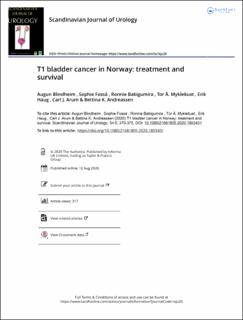| dc.contributor.author | Blindheim, Augun Jodis | |
| dc.contributor.author | Fosså, Sophie Dorothea | |
| dc.contributor.author | Babigumira, Ronnie | |
| dc.contributor.author | Myklebust, Tor Åge | |
| dc.contributor.author | Haug, Erik Skaaheim | |
| dc.contributor.author | Arum, Carl-Jørgen | |
| dc.contributor.author | Kulle, Bettina | |
| dc.date.accessioned | 2020-11-11T08:36:08Z | |
| dc.date.available | 2020-11-11T08:36:08Z | |
| dc.date.created | 2020-08-20T08:55:29Z | |
| dc.date.issued | 2020 | |
| dc.identifier.citation | Scandinavian Journal of Urology. 2020, 54 (5), . | en_US |
| dc.identifier.issn | 2168-1805 | |
| dc.identifier.uri | https://hdl.handle.net/11250/2687253 | |
| dc.description.abstract | Aim: Evaluation of treatment and survival of pT1 stage (T1) bladder cancer (BC) patients diagnosed with transitional cell carcinoma of the urinary bladder in Norway. Material and methods: According to the Cancer Registry of Norway, 1,108 patients were diagnosed with T1 BC between 2008-2012. Information on surgical and medical procedures was provided by the Norwegian Patients Registry. Regression and survival models were applied to characterize patients receiving bacillus Calmette-Guerin (BCG) and radical cystectomy (RC) as early and delayed treatment and to estimate overall and cause specific survival rates (OS; CSS). Adjustments for sex, age, WHO grade and concomitant cis were made. Results: In total, 449 (41%) patients received BCG treatment, 162 (15%) as early treatment. RC represented the early treatment in 96 (9%) patients and the delayed treatment in 84 (8%). Overall, 850 (77%) patients received neither BCG nor RC as early treatment, of whom 287 (26%) were treated with BCG and 66 (6%) with RC during follow-up. Patients <75 years and patients with high grade tumors or concomitant cis were more likely to receive BCG and RC as early treatment. 5-year survival rates for all T1 BC patients were 84% (CSS) and 65% (OS). Delayed RC was associated with the lowest 5-year CSS (70%). After adjustment, gender did not impact treatment choice and CSS. Conclusions: The use of BCG as early treatment indicates low adherence to existing guidelines. Delayed RC was associated with low survival rates. An increased focus on the management of T1 patients is needed in Norway. | en_US |
| dc.language.iso | eng | en_US |
| dc.publisher | Taylor & Francis | en_US |
| dc.rights | Attribution-NonCommercial-NoDerivatives 4.0 Internasjonal | * |
| dc.rights.uri | http://creativecommons.org/licenses/by-nc-nd/4.0/deed.no | * |
| dc.title | T1 bladder cancer in Norway: treatment and survival | en_US |
| dc.type | Peer reviewed | en_US |
| dc.type | Journal article | en_US |
| dc.description.version | publishedVersion | en_US |
| dc.source.volume | 54 | en_US |
| dc.source.journal | Scandinavian Journal of Urology | en_US |
| dc.source.issue | 5 | en_US |
| dc.identifier.doi | 10.1080/21681805.2020.1803401 | |
| dc.identifier.cristin | 1824207 | |
| dc.description.localcode | © 2020 The Author(s). Published by Informa UK Limited, trading as Taylor & Francis Group This is an Open Access article distributed under the terms of the Creative Commons Attribution-NonCommercial-NoDerivatives License (http://creativecommons.org/licenses/by-nc-nd/4.0/), which permits non-commercial re-use, distribution, and reproduction in any medium, provided the original work is properly cited, and is not altered, transformed, or built upon in any way. | en_US |
| cristin.ispublished | true | |
| cristin.fulltext | original | |
| cristin.qualitycode | 1 | |

